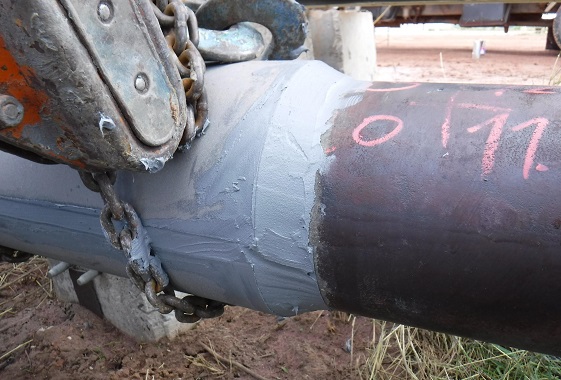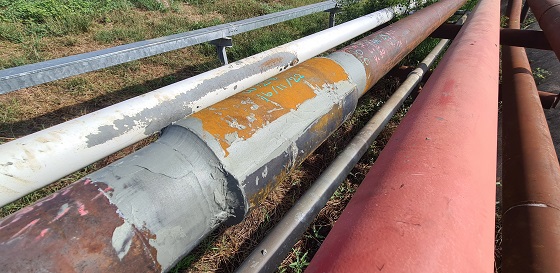Utilizing unique cold-bonding technology from industrial protective coatings and composites manufacturer Belzona, a “mammoth” pipeline restoration project was recently completed in Thailand. The prominent oil and gas client wishes not to be named.
The client’s facility, located in north Thailand, featured a huge pipeline carrying high-pressure water for injection into oil wells. However, this pipeline was suffering from thin-wall defects at weld seams, which occurred due to high chloride content found in process fluids.
The pipeline was comprised of 12-meter lengths that were welded together. Several years ago, inspections determined that 2,000-psi (13.8 Mpa) water contents and a weld-filler material had resulted in internal corrosion defects at every circumferential weld joint. In turn, this caused deterioration of the pipe’s wall thickness and risked high-pressure leaks.
Cold-Bonding Benefits
The client had a previous relationship with Belzona and Pan Mechanic Engineering Co., Ltd., the company’s local distributor and applicator. According to the manufacturer, they were impressed by Belzona’s cold-bonding capabilities when the distributor demonstrated this technology on a defective joint. That led to an agreement to repair the entire pipeline, which required an estimated 5,000 to 7,000 kg of Belzona 1111 (Super Metal).
A two-part repair composite for metal repair and resurfacing, Belzona 1111 is based on a solvent-free epoxy resin reinforced with silicon steel alloy. The two-part epoxy sets up quickly, so all coating is mixed at the site. The coating, which fills small holes and pits while reinforcing weak metal, comes with a specialized plastic application device with one flat side like a scraper or squeegee, and the other side featuring different configurations for different substrates.
“Belzona 1111 was the perfect choice for them due to its excellent chemical resistance against a wide range of chemicals and its ease of use for this application,” said Panit Kittikunakorn, project manager for Pan Mechanic Engineering. At a company level, the manufacturer and distributor have worked together in Thailand for more than 35 years.

Three Project Stages
Due to the massive scale of the Thailand project, it was decided to complete the repair in three stages. More than 1,000 joints were repaired in 2020, while the remaining defects were addressed in November and December of 2022.
The joints repaired in stage one had demonstrated excellent in-service performance over the next two years, according to the manufacturer, which brought more confidence in this technology being the optimal solution. To observe the project’s next stages, the distributor invited two technical services engineers from Belzona’s Asia-Pacific office for oversight.
The use of welding had been problematic for the client in the past, which led them to seek out cold-bonding alternatives. The distributor initially proposed using Belzona’s SuperWrap II to restore the pipe’s wall strength, but testing found that attaching carbon-steel reinforcing plates using Belzona 1111 as a bonding agent was more appropriate. Ultimately, the simpler cold-bonding repair was found to be cost effective while also ensuring a faster return to service.
In addition to testing results, the applicator cited the number of affected weld seams and the site’s relatively low operating pressures as contributing factors.
Application Techniques
The surface was prepared using garnet blasting and the Belzona 9111 cleaner/degreaser to achieve an average 3-mil (76.2 microns) profile while meeting the NACE No. 2/Society for Protective Coatings (SSPC) Surface Preparation (SP) 10/Sa 2 ½ standard for a “Near-White Metal Blast Cleaning.” Atmospheric conditions were tested to ensure the relative humidity was below 85%, which was the maximum level for the application to take place.
To apply the new system, welding rods were installed so that applicators could create a shim between the steel plates and repair areas. In turn, this allowed them to control the thickness. The welding rods were bonded to steel plates with a small quantity of Belzona 1111, while repair areas were identified using masking tape. Crew members worked using standard personal protective equipment such as steel-toed boots, safety glasses, gloves, and hard hats.
Belzona 1111 was first applied to two of the four plates and a damaged pipeline joint. While the product cured, it was held in place using a fixed hoist. Once the first two plates had bonded, the final two plates were applied and allowed to cure, fully encompassing the circumferential joint. Using the supplied plastic device, the heavy-duty system was applied by hand at an average of 75–100 mils (1,905.0–2,540.0 microns) of dry film thickness.
Ensuring Pipeline Integrity
According to the manufacturer, this project represented the largest order it has ever received for Belzona 1111. Best of all, the Thai client was delighted by its results, noting that this repair method had restored the integrity of its joints while protecting the pipeline from future defects.
Even better, the success of this massive project is prompting the client to explore new technologies to help other pipelines at its facility, as well. This may include similar cold-bonding applications, Belzona explains, or perhaps the specification of a SuperWrap II composite repair system for more complex pipe geometries.
